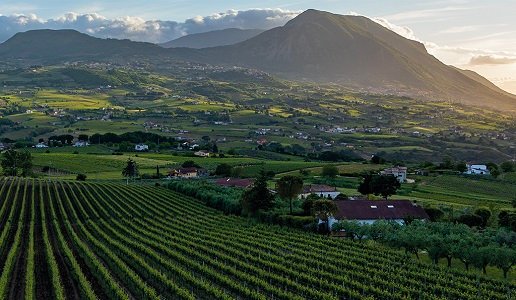An area that occupies first place in the Campania wine sector and where Falanghina and Aglianico are the masters.
Ten thousand hectares planted with vines, seven thousand nine hundred winemakers, about one hundred bottling companies for more than one million hectoliters of wine produced, three appellations of origin and one geographical indication for more than sixty types of wines, a potential of one hundred million bottles. These are the salient features of the Sannio vineyard, assigning the Benevento province first place in the Campania wine sector (about 50 percent of the regional wine-growing area and wine production).
 Important numbers for the Samnite territory, which in addition to being a land of wine is also a land of oil and gastronomic excellence (Pietraroja ham, Pietrelcina artichoke, Laticauda pecorino cheese, to name a few), bordering Irpinia to the south, Casertano to the west, Molise to the north and Puglia to the east. A landscape where the strong winemaking tradition is tangible with miles and miles of vine-covered hillsides, where in addition to Aglianico (makes up 28 percent of cultivation) and Falanghina (12 percent), there is a rich biodiversity of grape varieties, such as Sommarello, Piedirosso, Sciascinoso, Agostinella, Cerreto, Coda di volpe, Grieco, Malvasia, Fiano, Passolara di San Bartolomeo, Olivella, Carminiello, Palombina and Moscato di Baselice.
Important numbers for the Samnite territory, which in addition to being a land of wine is also a land of oil and gastronomic excellence (Pietraroja ham, Pietrelcina artichoke, Laticauda pecorino cheese, to name a few), bordering Irpinia to the south, Casertano to the west, Molise to the north and Puglia to the east. A landscape where the strong winemaking tradition is tangible with miles and miles of vine-covered hillsides, where in addition to Aglianico (makes up 28 percent of cultivation) and Falanghina (12 percent), there is a rich biodiversity of grape varieties, such as Sommarello, Piedirosso, Sciascinoso, Agostinella, Cerreto, Coda di volpe, Grieco, Malvasia, Fiano, Passolara di San Bartolomeo, Olivella, Carminiello, Palombina and Moscato di Baselice.
In this scenario of grape heritage, which contribute to enriching the production fabric, small and large wineries and cooperatives produce wines that tour the world, popularizing the territory and the history of this land, characterized by cultures that have succeeded one another over time, such as the long Longobard domination that indelibly designed the local landscape.
 For first-time visitors to Sannio, the majestic silhouette of the Taburno massif is striking, intersecting with the Matese Mountains, the castle and village of Guardia Sanframondi and that of Sant’Agata de’ Goti, and the countless Regional Nature Parks.
For first-time visitors to Sannio, the majestic silhouette of the Taburno massif is striking, intersecting with the Matese Mountains, the castle and village of Guardia Sanframondi and that of Sant’Agata de’ Goti, and the countless Regional Nature Parks.
Talking about the wines of Sannio means mentioning Falanghina, a symbolic wine of the territory, a transversal grape variety with great aging potential, and thenAglianico del Taburno, of the bitter biotype, the most widespread one, which gives austere wines that only with time reveal elegance and complexity.
This was followed by a tasting of four Falanghina del Sannio Doc and four Aglianico del Taburno Docg. Click on the names to open the tabs.











